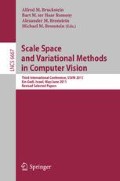Abstract
We propose a variational approach to unsupervised texture segmentation that depends on very few parameters and is robust to imaging conditions. First, the uneven illumination in the observed image is removed by the proposed image decomposition model that approximates the illumination and well retains the textures and features in the image. Then, from the obtained intrinsic image, we introduce a new data, multiscale local entropy, which is the entropy of each location’s neighborhood histogram with various scales. The proposed segmentation model uses multiscale local entropy as data. Together with a length penalizing term, minimizing the energy functional locates the contours so that the local entropy within each region is similar to one another. Since entropy is the only feature, there are very few parameters. Moreover, the segmentation model can be solved by a fast global minimization method. Experimental results on natural images show the proposed method is able to robustly segment various texture patterns with uneven illumination in the original images.
Access this chapter
Tax calculation will be finalised at checkout
Purchases are for personal use only
Preview
Unable to display preview. Download preview PDF.
References
Mumford, D., Shah, J.: Optimal approximations by piecewise smooth functions and associated variational problems. Comm. Pure Appl. Math. 42(5), 577–685 (1989)
Ambrosio, L., Tortorelli, V.M.: Approximation of functionals depending on jumps by elliptic functionals via gamma convergence. Comm. on Pure and Applied Math. 43, 999–1036 (1990)
Chan, T., Vese, L.A.: Active contours without edges. IEEE Trans. on Image Processing 10(2), 266–277 (2001)
Jain, A.K., Farrakhonia, F.: Unsupervised texture segmentation using gabor filters. Pattern Recognition 23(12), 1167–1186 (1991)
Chan, T., Sandberg, B., Vese, L.: Active contours without edges for textured images. UCLA Comput. Appl. Math. Rep. 02-39 (2002)
Sagiv, C., Sochen, N.A., Zeevi, Y.Y.: Integrated active contours for texture segmentation. IEEE Transactions on Image Processing 15(6), 1633–1646 (2006)
Portilla, J., Simoncelli, E.P.: A parametric texture model based on joint statistics of complex wavelet coefficients. International Journal of Computer Vision 40(1)
Manjunath, B.S., Chellappa, R.: Unsupervised texture segmentation using markov random field models. IEEE Transactions on Pattern Analysis and Machine Intelligence 13(5), 478–482 (1991)
Zhu, S.C., Yuille, A.: Region competition: Unifying snakes, region growing, and bayes/mdl for multiband image segmentation. IEEE Trans. on Pattern Analysis and Machine Intelligence 18(9), 884–900 (1996)
Yezzi, J.A., Tsai, A., Willsky, A.: A statistical approach to snakes for bimodal and trimodal imagery. In: Int. Conf. on Computer Vision, pp. 898–903 (1999)
Paragios, N., Deriche, R.: Geodesic active regions and level set methods for supervised texture segmentation. International Journal of Computer Vision 46(3)
Rousson, M., Brox, T., Deriche, R.: Active unsupervised texture segmentation on a diffusion based feature space. In: Computer Vision and Pattern Recognition
Aubert, G., Barlaud, M., Faugeras, O., Jehan-Besson, S.: Image segmentation using active contours: Calculus of variations or shape gradients? SIAM Appl. Math. 1(2), 2128–2145 (2003)
Herbulot, A., Jehan-Besson, S., Duffner, S., Barlaud, M., Aubert, G.: Segmentation of vectorial image features using shape gradients and information measures. J. Math. Imaging and Vision 25(3), 365–386 (2006)
Kim, J., Fisher, J.W., Yezzi, A., Cetin, M., Willsky, A.S.: A nonparametric statistical method for image segmentation using information theory and curve evolution. IEEE Trans. on Image Processing 14, 1486–1502 (2005)
Awate, S.P., Tasdizen, T., Whitaker, R.T.: Unsupervised texture segmentation with nonparametric neighborhood statistics. In: Leonardis, A., Bischof, H., Pinz, A. (eds.) ECCV 2006. LNCS, vol. 3952, pp. 494–507. Springer, Heidelberg (2006)
Michailovich, O., Rathi, Y., Tannenbaum, A.: Image segmentation using active contours driven by the bhattacharya gradient flow. IEEE Trans. on Image Processing 16(11), 2787–2801 (2007)
Ni, K., Bresson, X., Chan, T., Esedoglu, S.: Local histogram based segmentation using the wasserstein distance. International Journal of Computer Vision 84(1), 97–111 (2009)
Li, C., Li, F., Kao, C.-Y., Xu, C.: IImage Segmentation with Simultaneous Illumination and Reflectance Estimation: An Energy Minimization Approach. In: Proc. of ICCV (2009)
Horn, B.K.P.: Robot Vision. MIT Press, Cambridge (1986)
Chen, T., Yin, W., Zhou, X.S., Comaniciu, D., Huang, T.S.: Total variation models for variable lighting face recognition. IEEE Trans. on Pattern Analysis and Machine Intelligence 28(9), 1519–1524 (2006)
Rudin, L., Lions, L., Osher, S.: Multiplicative denoising and deblurring: theory and algorithms, vol. 445. Springer, Heidelberg (2003)
Le, T.M., Vese, L.A.: Additive and Multiplicative piecewise-smooth segmentation models in a functional minimization approach. Contemporary Mathematics (2007)
Aujol, J.F., Gilboa, G., Chan, T., Osher, S.: Structure-texture image decomposition - modeling, algorithms, and parameter selection. International Journal of Computer Vision 67(1), 111–136 (2006)
Chan, T., Esedoglu, S., Nikolova, M.: Algorithms for finding global minimizers of image segmentation and denoising models. SIAM Journal on Applied Mathematics 66(5), 1632–1648 (2006)
Bresson, X., Esedoglu, S., Vandergheynst, P., Thiran, J.P., Osher, S.: Fast global minimization of the active contour/snake model. Journal of Mathematical Imaging and Vision 28(2), 151–167 (2007)
Author information
Authors and Affiliations
Editor information
Editors and Affiliations
Rights and permissions
Copyright information
© 2012 Springer-Verlag Berlin Heidelberg
About this paper
Cite this paper
Hong, BW., Ni, K., Soatto, S. (2012). Entropy-Scale Profiles for Texture Segmentation. In: Bruckstein, A.M., ter Haar Romeny, B.M., Bronstein, A.M., Bronstein, M.M. (eds) Scale Space and Variational Methods in Computer Vision. SSVM 2011. Lecture Notes in Computer Science, vol 6667. Springer, Berlin, Heidelberg. https://doi.org/10.1007/978-3-642-24785-9_21
Download citation
DOI: https://doi.org/10.1007/978-3-642-24785-9_21
Publisher Name: Springer, Berlin, Heidelberg
Print ISBN: 978-3-642-24784-2
Online ISBN: 978-3-642-24785-9
eBook Packages: Computer ScienceComputer Science (R0)

